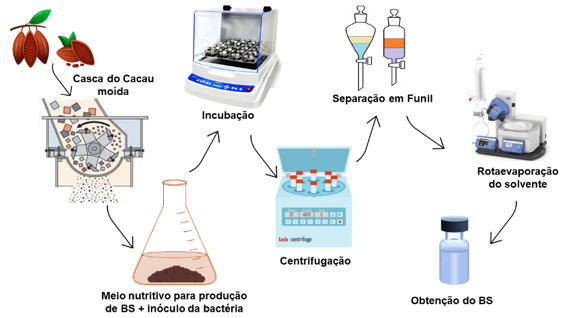Biosurfactant production by Pseudomonas aeruginosa using cocoa (Theobroma cacao L.) residue and its potential in oil dispersion
DOI:
https://doi.org/10.37002/biodiversidadebrasileira.v15i1.2637Keywords:
Amazon; renewable sources; bacterium; tensoativeAbstract
Biosurfactants (BS) are molecules of significant industrial relevance, recognized for their surfactant properties and potential for production by microorganisms utilizing alternative carbon and energy sources. Cocoa (Theobroma cacao L.), an Amazonian fruit extensively utilized as a raw material in chocolate production, presents an exemplary alternative resource. Despite the lack of economic value attributed to the residues generated from cocoa processing, these by-products can be transformed into valuable substrates for BS production. This study evaluates the efficacy of Pseudomonas aeruginosa BM02 in producing BS, leveraging cocoa waste as the primary substrate, and further investigates the potential of the resulting BS as an oil dispersant. The crude BS exhibited a rhamnolipid concentration of 3.06 g/L and an emulsification index of 60%, significantly influencing its oil dispersion capacity, measured at 2.5 cm²/min after 10 minutes. These findings underscore the viability, innovation, and sustainability of utilizing cocoa residues as feedstock for BS production, with promising applications for bioremediation of hydrocarbon-contaminated areas. Furthermore, this approach contributes directly to the circular economy in the Amazon, as the sustainable utilization of processing waste demonstrates potential for enhancing added value within the local production chain, thus providing important social implications by fostering economic growth in the region.
Downloads
References
Sousa RSR, Lima GVS, Garcias JT, et al (2024) The Microbial Community Structure in the Rhizosphere of Theobroma cacao L. and Euterpe oleracea Mart. Is Influenced by Agriculture System in the Brazilian Amazon. Microorganisms 12:398. https://doi.org/10.3390/microorganisms12020398 DOI: https://doi.org/10.3390/microorganisms12020398
Cabral MVA, Conceição MMM, Bitencourt EB, et al (2024) Açaí, castanha e palmito: elementos da bieconomia e da sociobiodiversidade no estado do Pará, Amazônia Brasileira. Caderno Pedagógico 21:e3842. https://doi.org/10.54033/cadpedv21n4-118 DOI: https://doi.org/10.54033/cadpedv21n4-118
Wagh MS, Sowjanya S, Nath PC, et al (2024) Valorisation of agro-industrial wastes: Circular bioeconomy and biorefinery process - A sustainable symphony. Process Safety and Environmental Protection 183:708-725. https://doi.org/10.1016/j.psep.2024.01.055 DOI: https://doi.org/10.1016/j.psep.2024.01.055
Brasília: Planalto (2010) BRASIL, 2010. http://www.palnalto.gov.br, Brasil
Younes A, Li M, Karboune S (2023) Cocoa bean shells: a review into the chemical profile, the bioactivity and the biotransformation to enhance their potential applications in foods. Crit Rev Food Sci Nutr 63:9111-9135. https://doi.org/10.1080/10408398.2022.2065659 DOI: https://doi.org/10.1080/10408398.2022.2065659
Cerqueira dos Santos S, Araújo Torquato C, de Alexandria Santos D, et al (2024) Production and characterization of rhamnolipids by Pseudomonas aeruginosa isolated in the Amazon region, and potential antiviral, antitumor, and antimicrobial activity. Sci Rep 14:4629. https://doi.org/10.1038/s41598-024-54828-w DOI: https://doi.org/10.1038/s41598-024-54828-w
Yadav S, Malik K, Moore JM, et al (2024) Valorisation of Agri-Food Waste for Bioactive Compounds: Recent Trends and Future Sustainable Challenges. Molecules 29:2055. https://doi.org/10.3390/molecules29092055 DOI: https://doi.org/10.3390/molecules29092055
Johnson P, Trybala A, Starov V, Pinfield VJ (2021) Effect of synthetic surfactants on the environment and the potential for substitution by biosurfactants. Adv Colloid Interface Sci 288:102340. https://doi.org/10.1016/j.cis.2020.102340 DOI: https://doi.org/10.1016/j.cis.2020.102340
Parthasarathi R, Mayakrishnan V, Natesan V, et al (2024) Serratia rubidaea SNAU02-mediated biosurfactant production from cashew apple bagasse: A promising biotechnological strategy for environmental sustainability. Biocatal Agric Biotechnol 58:103158. https://doi.org/10.1016/j.bcab.2024.103158 DOI: https://doi.org/10.1016/j.bcab.2024.103158
Hari A, Doddapaneni TRKC, Kikas T (2024) Common operational issues and possible solutions for sustainable biosurfactant production from lignocellulosic feedstock. Environ Res 251:118665. https://doi.org/10.1016/j.envres.2024.118665 DOI: https://doi.org/10.1016/j.envres.2024.118665
Cheng T, Liang J, He J, et al (2017) A novel rhamnolipid-producing Pseudomonas aeruginosa ZS1 isolate derived from petroleum sludge suitable for bioremediation. AMB Express 7:120. https://doi.org/10.1186/s13568-017-0418-x DOI: https://doi.org/10.1186/s13568-017-0418-x
Chang SE, Stone J, Demes K, Piscitelli M (2014) Consequences of oil spills: a review and framework for informing planning. Ecology and Society 19:art26. https://doi.org/10.5751/ES-06406-190226 DOI: https://doi.org/10.5751/ES-06406-190226
Iqbal S, Khalid ZM, Malik KA (1995) Enhanced biodegradation and emulsification of crude oil and hyperproduction of biosurfactants by a gamma ray-induced mutant of Pseudomonas aeruginosa. Lett Appl Microbiol 21:176-179. https://doi.org/10.1111/j.1472-765X.1995.tb01035.x DOI: https://doi.org/10.1111/j.1472-765X.1995.tb01035.x
Camilios Neto D, Meira JA, de Araújo JM, et al (2008) Optimization of the production of rhamnolipids by Pseudomonas aeruginosa UFPEDA 614 in solid-state culture. Appl Microbiol Biotechnol 81:441-448. https://doi.org/10.1007/s00253-008-1663-3 DOI: https://doi.org/10.1007/s00253-008-1663-3
Pele MA, Ribeaux DR, Vieira ER, et al (2019) Conversion of renewable substrates for biosurfactant production by Rhizopus arrhizus UCP 1607 and enhancing the removal of diesel oil from marine soil. Electronic Journal of Biotechnology 38:40-48. https://doi.org/10.1016/j.ejbt.2018.12.003 DOI: https://doi.org/10.1016/j.ejbt.2018.12.003
Santos SC (2019) Biossurfactantes: potenciais agentes biorremediadores. Cadernos de Prospecção 12:1531. https://doi.org/10.9771/cp.v12i5.33191 DOI: https://doi.org/10.9771/cp.v12i5.33191
Wei Y-H, Chou C-L, Chang J-S (2005) Rhamnolipid production by indigenous Pseudomonas aeruginosa J4 originating from petrochemical wastewater. Biochem Eng J 27:146-154. https://doi.org/10.1016/j.bej.2005.08.028 DOI: https://doi.org/10.1016/j.bej.2005.08.028
Pinto MH, Martins RG, Costa JAV (2009) Avaliação cinética da produção de biossurfactantes bacterianos. Quim Nova 32:2104-2108. https://doi.org/10.1590/S0100-40422009000800022 DOI: https://doi.org/10.1590/S0100-40422009000800022
Araujo JS, Rocha JC, Filho MAO, et al (2020) Production of Rhamnolipids by Pseudomonas aeruginosa AP029-GLVIIA and Application on Bioremediation and as a Fungicide. Biosci Biotechnol Res Asia 17:467-477. https://doi.org/10.13005/bbra/2850 DOI: https://doi.org/10.13005/bbra/2850
Jiang J, Jin M, Li X, et al (2020) Recent progress and trends in the analysis and identification of rhamnolipids. Appl Microbiol Biotechnol 104:8171-8186. https://doi.org/10.1007/s00253-020-10841-3 DOI: https://doi.org/10.1007/s00253-020-10841-3

Published
Issue
Section
License
Copyright (c) 2025 Os autores mantêm os direitos autorais de seus artigos sem restrições, concedendo ao editor direitos de publicação não exclusivos.

This work is licensed under a Creative Commons Attribution-NonCommercial-NoDerivatives 4.0 International License.
Os artigos estão licenciados sob uma licença Creative Commons Atribuição-NãoComercial-SemDerivações 4.0 Internacional (CC BY-NC-ND 4.0). O acesso é livre e gratuito para download e leitura, ou seja, é permitido copiar e redistribuir o material em qualquer mídia ou formato.











